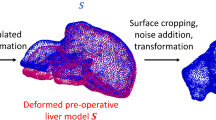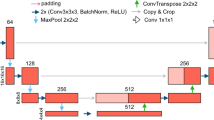Abstract
Three dimensional visualisation techniques have been used as a powerful tool in surgical and therapeutic applications. Due to large medical data, huge computations are necessary on 3D visualisation, especially for a real-time system. Many existing methods are sequential, which are too slow to be practical in real applications. In our previous work, we showed boundary detection and feature points extraction by using Hopfield networks. In this paper, a new feature points matching method for 3D surfaces using a Hopfield neural network is proposed. Taking advantage of parallel and energy convergence capabilities in the Hopfield networks, this method is faster and more stable for feature points matching. Stereoscopic visualisation is the display result of our system. With stereoscopic visualisation, the 3D liver used in the experiment can leap out of the screen in true 3D stereoscopic depth. This increases a doctor's ability to analyse complex graphics.
Similar content being viewed by others
References
Rhodes ML. Computer Graphics in Medicine: The Past Decade. IEEE Computer Graphics & Application 1991: 52–54.
Lacroute PG. Fast volume rendering using a shear-warp factorization of the viewing trnasformation. PhD Thesis, September 1995.
Frieder G, Gordon G, Reynolds RA. Back-to-front display of voxel-based objects. IEEE Computer Graphics & Applications 1985: 52–60.
Dennis AR. An overview of rendering techniques. Chen RLS, Herman GT, Reynolds RA, Udupa JK. Surface rendering in the cuberille environment. IEEE Computer Graphics & Applications 1985: 33–43.
Tiede U, Heinz K, Bomans M, Pommert A, Riemer M, Wiebecke G. Investigation of Medical 3D-Rendering Algorithms. IEEE Computer Graphics & Applications 1990: 41–43.
Frieder G, Gordoh D, Reynolds RA. Back-to-Front display of Voxel-based Objects. IEEE Computer Graphics & Applications 1985: 52–60.
Lent R, Gudmundsson B, Lindskog B, Danielsson E. Display of Density Volumes. IEEE Computer Graphics & Applications 1986: 20–29.
Drebin RA, Carpenter L, Hanrahan P. Volume rendering. Computer Graphics 1988: 22: 65–74.
Chen HH, Huang TS. A survey of construction and manipulation of octtrees. Computer Vision, Graphics, and Image Processing 1988: 43: 409–431.
Chen LS, Sontag MR. Representation display, and manipulation of 3D digital scenes and their medical applications. Computer Vision, Graphics, and Image Processing 1989: 48: 190–216.
Lorensen WE, Cling HE. Marching cubes: A high resolution 3D surface construction algorithm. Computer Graphics 1987: 21(4): 163–169.
Keppel E. Approximating complex surfaces by triangulation of contour lines. IBM J Res Dev 1976; 19: 2–11.
Fuchs H, Kedem ZM, Uselton SM. Optical surface reconstruction from planar contours. Communications ACM 1977; 100: 693–702.
Wang YF, Aggarwal JK. Surface reconstruction and representation of 3D scenes. Patt Recognition 1986: 19(3): 197–207.
Sinclain B, Hannam AG, Lowe AA, Wod WW. Complex contours organization for surface reconstruction. Computer & Graphics 1989; 13(3): 311–319.
Kehtarnavaz N. A framework for surface reconstruction from 3D contours. Computer Vision, Graphics, and Image Processing 1988: 42: 32–47.
Xu SB, Lu WX. Surface reconstruction of 3D object in computerised tomography. Computer Vision, Graphics and Image Processing 1988: 270–278.
Terzopoulos D. The computation of visible-surface representations. IEEE Trans PAMI 1988; 100(4): 417–436.
Lin WC, Liang CC, Chen CT. Dynamic elastic interpolation for 3D medical image reconstruction from serial cross sections. IEEE Trans Medical Imaging 1988: 7(3): 225–232.
Chen SY, Liang WC, Chen CT. Improvement on dynamic elastic interpolation technique for reconstructing 3D objects from serial cross sections. IEEE Trans Medical Imaging 1990: 9(1): 71–83.
Liu YH, Mao CW, Sun YN. 3D reconstruction, registration, and fusion for multimodality medical images. PhD Thesis, Department of Electrical Engineering, National Cheng Kung University, Taiwan, ROC, 1997.
Tsai CT, Sun YN, Chung PC, Lee JS. Endocardial boundary detection using a neural network. Patt Recognition 1993; 26(7): 1057–1068.
Tsai C-T, Sun Y-N, Chung P-C. Minimizing the energy of active contour model using a Hopfield network. IEE Proc-E: Computers and Digital Techniques 1993; 140(6): 297–303.
Chung P-C, Tsai C-T, Liang E, Sun Y-N. Polygonal approximation using a competitive Hopfield neural network. Patt Recognition 1994; 27(11): 1505–1512.
Ferguson JC. Multivariate curve interpolation. J ACM 1964; 11(2): 221–228.
Angel E. Interactive Computer Graphics. Reading, MA: Addison-Wesley, 1997.
Hopfield JJ, Tank DW. Neural computer of decisions in optimization problems. Biol Cybern 1985; 52: 141–152.
Tank DW, Hopfield JJ. Simple optimization networks: A/D converter and a linear programming circuit. IEEE Trans Circuit Systems 1986; 33: 533–541.
Lin WC, Liao FY, Tsao CK, Lingutla T. A hierarchical multiple-view approach to three-dimensional object recognition. IEEE Trans Neural Networks 1991; 2(1): 84–92.
Nasrabadi NM, Choo CY. Hopfield network for stereoscopic vision correspondence. IEEE Trans Neural Networks 1992; 3(1): 5–13
Author information
Authors and Affiliations
Corresponding author
Rights and permissions
About this article
Cite this article
Tsai, C.T., Wang, J.H. & Sun, Y.N. Liver stereoscopic visualisation by using Hopfield neural nets. Neural Comput & Applic 7, 229–237 (1998). https://doi.org/10.1007/BF01414884
Issue Date:
DOI: https://doi.org/10.1007/BF01414884




